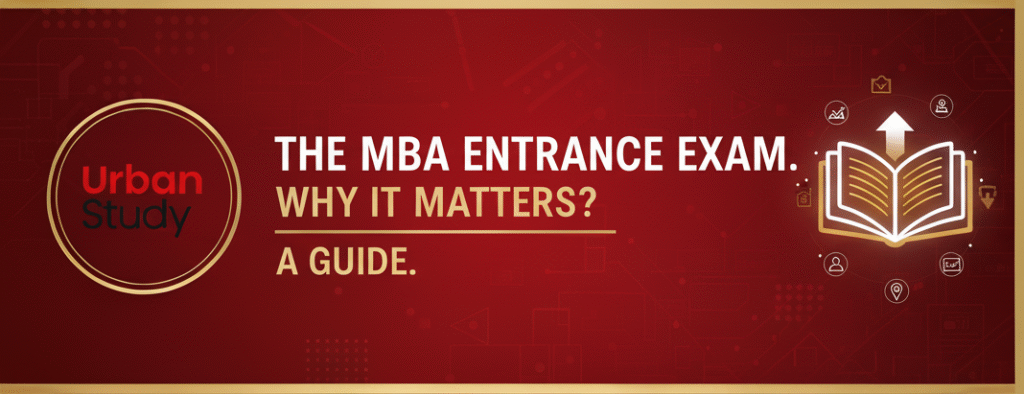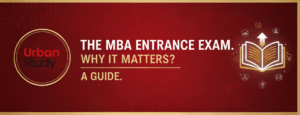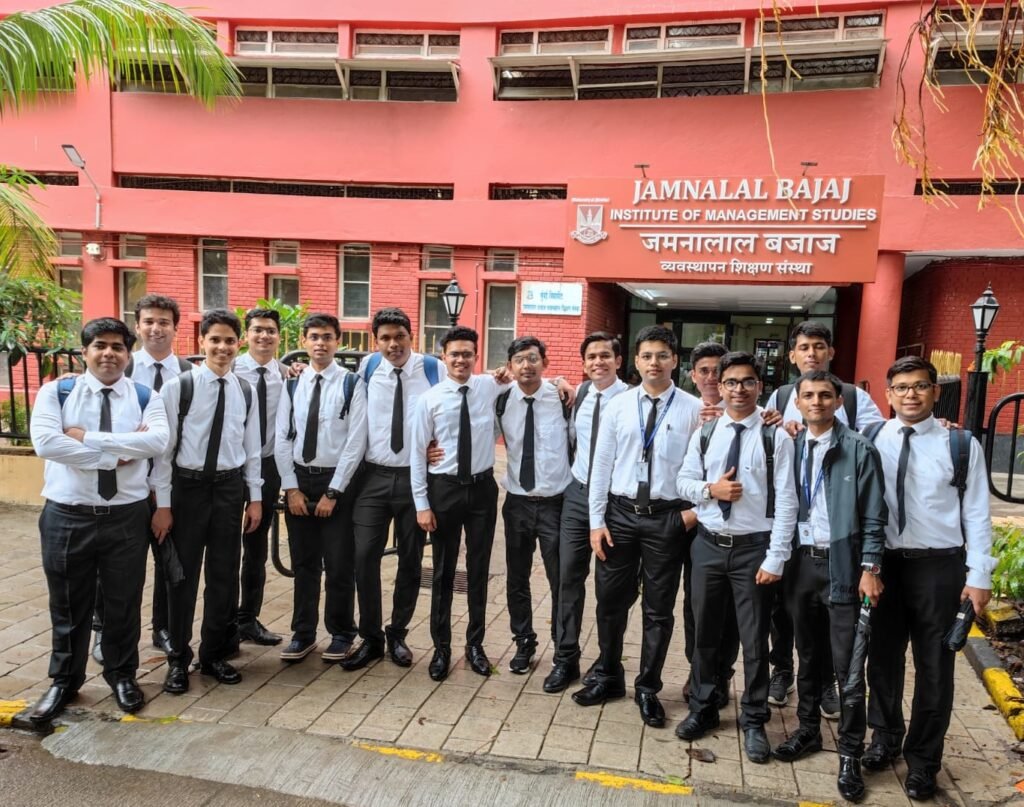
Introduction to the MBA entrance exam.
MBA full form is Master of Business Administration. The MBA entrance exam is necessary because it is an important step in building a student’s career. For students who want to pursue MBA courses from reputed colleges and are interested in building a career in leadership and pursuing a business management degree, taking the MBA entrance exam is a crucial step. The MBA entrance exam assesses the skills of students, including reasoning, communication, and problem-solving.
Choosing the MBA courses opens doors in many ways, such as securing a reputable MBA job, earning a high MBA salary package. Before choosing the MBA courses, students should know and understand the MBA syllabus, MBA subjects, and MBA fees. Why MBA entrance exams exist, types of MBA entrance exams in India, CAT exam syllabus for MBA, Exam patterns, eligibility, Preparation strategy and tips, and what comes next after the MBA entrance exam.
Why MBA Entrance exam exist?
This is important because it helps in selecting the right student for business management programs. Students in thousands of numbers from every city and college apply for the MBA entrance exams. In order to have a fair and uniform system for evaluating everyone, the MBA entrance exam is necessary. To build a successful career in management studies, it is very important to have these skills: Logical reasoning, language ability, and numerical problem-solving. These are the skills that are very important in completing the MBA syllabus.
The first step is scoring good marks in the MBA exam, then the next step is group discussion, interview, and writing ability tests. This stage helps the student understand if he/she will be able to handle the MBA subjects. The entrance exam helps the college in selecting the students who will be able to handle the MBA coursework. The second step is also very necessary because it makes us see whether the candidate can communicate their ideas clearly and can work as a team with other members. Every step is very important in gaining good MBA jobs with a good MBA salary package.
Types of MBA Entrance Exams in India
There are three types of MBA entrance exams in India.
- National Level
CAT (Common Admission Test) – Conducted by the IIMs for admission in all Indian Institutes of Management and other top business schools.
CMAT ( Common Management Admission Test) – This is a national-level exam for admission in AICTE-approved colleges.
MAT (Management Aptitude Test) – This test is widely accepted in many business schools across India.
- State Level
MAH MBA CET – Common entrance test for management programs in Mumbai
TANCET – Tamil Nadu Common Entrance Test for MBA programs in TN
AP-ICET – Integrated Common Entrance Test for Andhra Pradesh
TS-ICET – Integrated Common Entrance Test for Telangana
KMAT – Karnataka Management Aptitude Test
- University/College Level
SNAP – Symbiosis National Aptitude Test- is used for admission to the Symbiosis International University Institutes.
NMAT by GMAC – This is used for admission to NMIMS and other partner schools.
IBSAT – This is the entrance exam for ICFAI Business School
IIFT – This entrance exam is for the Indian Institute of Foreign Trade
Every exam follows a unique MBA syllabus & MBA courses in India.
Key MBA Entrance Exams & Their Features
CAT (Common Admission Test) – CAT is conducted once a year, usually in November, by IIMs. CAT is accepted by all IIMs, FMS, MDI, SPDJIMR, IITS, IMI, and 1300 + B schools. Out of all the MBA entrance exams in India, CAT is the toughest and the most prestigious MBA exam. There is no CAT exam syllabus for MBA officially announced, so the student has to prepare for the exam with the help of the CAT previous years’ papers and the CAT mock tests.
Since the year 1950, the CAT exam has been conducted each year, and more than two lakh students appear for the exam. The CAT exam has about 100 MCQ questions, and 180 minutes of time is given to complete the paper. Clearing the CAT paper can help you get admission in top colleges, which offer MBA courses with great placement opportunities and an MBA Salary.
CMAT (Common Management Admission Test) – The CMAT is conducted by NTA in March to April. CMAT is accepted by JBIMS, K J Somaiya, GIM Goa, and 1000+ institutes. CMAT is a moderate-level exam. It is the next important exam after CAT. This test was initiated in the year 2012 by the National Testing Agency. Students who are preparing for the exam are advised to use the CMAT previous year’s papers and the best books for CMAT preparation 2023. CMAT is an online format exam held for 180 minutes. The CMAT exam syllabus is divided into 4 sections as per the latest MBA syllabus: Quantitative Technique, Logical Reasoning, Language Comprehension, and General Awareness.
XAT(Xavier Aptitude Test) – XAT is a computer-based aptitude test. This test is conducted by XLRI Jamshedpur, and approximately 1 lakh candidates appear for this exam. The exam is held in the month of January every year. The XAT exam syllabus is divided into 4 sections – Quantitative Ability, English Language & Logical Reasoning, Decision Making, and General Knowledge, which are taught in most MBA subjects.
MAT/NMAT/SNAP – MAT is also a popular National entrance exam for MBA in India. This exam is conducted four times a year. NMAT is conducted by the Graduate Management Admission Council. This exam is held three times a year. The NMAT exam pattern and syllabus have three sections, i.e., Language skills, Quantitative skills, and Logical Reasoning. These skills build the foundation of every MBA course and are very important for getting MBA jobs.SNAP is accepted by 15 institutes that work under the Symbiosis International University. Registration of SNAP starts in the month of August till November. It is a computer-based exam, and the syllabus is divided into three sections: General English, Data Interpretation & Data Sufficiency, Analytical & Logical Reasoning, and Quantitative.
MBA Entrance Exam Pattern, Eligibility & Changes
Given below is the detailed table for general eligibility criteria, recent changes in patterns & schedules –
CAT (2024-2025)
| Parameters | Details |
| Sections | VARC (Verbal Ability & Reading Comprehension), DILR (Data Interpretation & Logical Reasoning), QA (Quantitative Aptitude) |
| No. of Questions | For 2024: – 66 questions For 2025: – 68 questions |
| Marks per question | +3 for each correct answer. For MCQs: −1 for each wrong answer. For non-MCQs (TITA) no negative marking |
| Total time | 120 minutes (40 minutes per section) |
| Total Marks | For 2024: 198 marks (66 q × 3) For 2025: 204 marks (68 q × 3) |
| Recent changes | In CAT 2024, the number of questions in DILR increased (from earlier ~20 to 22) |
XAT (2025)
| Parameter | Details |
| Sections | Verbal Ability & Logical Reasoning, Decision Making, Quantitative Ability & Data Interpretation, General Knowledge (and sometimes Essay) |
| Total no. of questions | 95 to 102 questions approx |
| Duration | 3 hours for 2025 |
| Marking scheme | +1 mark for each correct answer; −0.25 for each incorrect answer. No negative marking in the GK section; the GK section may not count toward the percentile in many institutes |
| Recent Changes | For 2025: The Essay writing section has been removed. The number of GK questions has been reduced. Exam duration has changed from the earlier format. |
CMAT (2025)
| Parameter | Details |
| Sections | 5 sections (e.g., Quantitative Techniques & Data Interpretation; Logical Reasoning; Language; General Awareness; Innovation & Entrepreneurship) |
| No of questions | 100 questions (20 in each section) for CMAT 2025. |
| Duration | 180 minutes |
| Marking scheme/Marks | +4 marks for each correct answer. −1 mark for each incorrect answer. No penalty for unattempted. |
| Recent Changes | Addition of the Innovation & Entrepreneurship section. Reduction in questions per section. |
NMAT (2025)
| Parameter | Details |
| Sections | Language Skills, Quantitative Skills, Logical Reasoning |
| No of questions | 108 questions |
| Duration | 2 hours |
| Marking scheme | No negative marking +3 marks for each correct answer (or +1 depending on source) 0 for wrong/unattempted |
| Recent changes | Emphasis on no negative marking. Adaptation of scaled scoring. Clarity of sectional time limits. |
The structure of the MBA entrance exam closely aligns with the MBA syllabus, which is taught in the first year. Students need to understand the pattern of each test and the MBA fees structure, which is there of the application process and admission.
How to Choose the Right MBA Entrance Exam for Yourself
It is very important to choose the right MBA Entrance exam for your future growth. First step one can take is to align exam choice with the target college. For example, if one aims for IIMs, CAT is very important for institutes like XLRI. CMAT and MAH-CET open doors for many good private and public B-schools across India. The second step is considering your desired specialization, location, and which type of college you are looking for.
Some of the exams are only preferred for certain streams, like XAT for Human Resource Management, CMAT for Innovation-focused courses. The last step is to evaluate the preparation time, test format, and retake options. Start and plan your preparation according to the MBA syllabus and identify those MBA subjects that match your potential in securing a good score.
Preparations Strategy & Tips for MBA Entrance Exam
| Aspect | Strategy & Tips |
| Time Table/Study Plan | Start before 6 to 8 months. Give daily 2 to 3 hours or more on weekends to cover the MBA syllabus. |
| Mock tests/Analysis | After 10 to 15 days, attempt a full mock test. The focus should be more on accuracy rather than attempting all questions. |
| Revision Strategy | Review the past year’s frequently asked question papers, and keep the last few weeks for revising the formulas, which are common in the MBA subjects. |
| Section-wise approach | Practice more mental calculations and shortcuts. Build vocabulary by reading newspapers and editorials. Focus more on speed and pattern recognition. |
| Stress Management | Take breaks between study hours. Practice relaxation techniques. |
| Resources and Tools | Books, Online Mocks, Apps, and Tools like Unacademy, Online YouTube lectures. |
Common Mistakes by the students and How to avoid Them
Students who sit for MBA Entrance Exams make some common mistake that hampers their overall performance.
- Last-minute cramming – Increases stress and confusion. Instead of this practice more on last-minute revisions. Focus on memorizing the key formulas rather than learning a whole new topic. Balance the preparation for all the MBA subjects.
- Ignoring the past year papers, Question patterns, difficulty level, and frequently tested topics can all be easily understood when one looks into the past year papers. To enhance the performance, at least 10 to 15 question papers need to be solved.
- Lack of Time management – Keep a clock timer when one sits to solve the paper. Increase the speed and accuracy with the timer.
- Neglecting the non-quantitative section – Every section should be given equal time. Keep a balance between the sections to secure the sectional cut-off easily.
What comes next: After the MBA Entrance Exam
The next step towards the MBA is Group Discussion, Personal Interviews, and Written Ability tests. Start studying current affairs, practice mock interviews. To enhance the overall profile, highlight the overall academic achievements, work experience, and relevant skills. Exam scores play a major role in shortlisting. Backup options have to be kept in mind. Institutes that accept multiple exam scores, like CAT, MAT, and CMAT, aim to increase the admission chances. Your overall performance brings a good chance to get you placed in reputed institutes with affordable MBA fees, where good placement records offer high MBA salary packages.
Conclusion
Preparing for the MBA entrance exam is all about strategy, consistency, and self-belief. Understand the exam patterns, target colleges, and maintain a timetable with mock tests and timely revisions. Keep a balanced time for all the sections. Go through the MBA syllabus. Start and plan the preparation at an early stage, and give time for concept understanding.
Always remember, every student’s journey is unique. Try staying focused, managing stress, and keep learning from every mock test. Patience, discipline will lead to a successful MBA entrance exam attempt with a good MBA job and a rewarding MBA salary in the future.
FAQs for MBA Entrance Exam
Which are the top MBA entrance exams in India?
CAT, MAT, XAT, CMAT, NMAT, SNAP & MAH-CET are the top MBA entrance exams in India.
What are the eligibility criteria for the MBA entrance exam?
Bachelor’s degree in any discipline with 50% marks from any recognized university
Is work experience necessary for admission to an MBA?
No, it is not necessary; fresh graduates are also accepted by some of the colleges. Whereas some of the executive MBA programs require 2-5 years of experience.
MBA entrance exams can be attempted how many times?
NMAT allows multiple attempts without a testing window.
What is the syllabus for MBA entrance exams?
Quantitative Aptitude, Verbal Ability, Logical Reasoning, Data Interpretation, and sometimes General Awareness.
How soon should the preparation start?
Prepare in advance for about 6 to 8 months with regular practice, mock tests.
What is a good score or percentile to get into a good college?
95-99 percentile in CAT is required for top IIMs, and 80-90 percentile for other reputed institutes.
Is coaching required to crack the exam?
Coaching can help with expert guidance, but with self-study and discipline, one can do well.
Can one apply to multiple exams simultaneously?
Most of the students who apply for 2–3 exams get to increase their chances of getting into a good B-school.
How important are GD, PI, and WAT rounds?
They are crucial for final selection, as they assess personality, communication skills, and motivation beyond academics.





